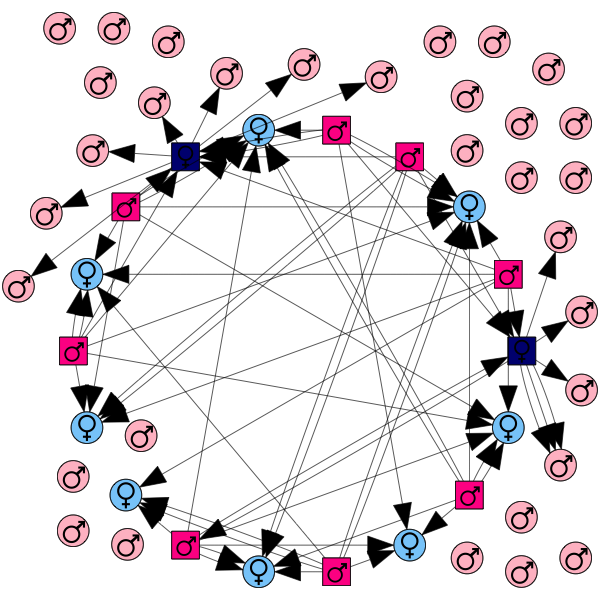A fun lecture…
A few months ago I spent an enjoyable hour or so listening to one of my fellow Professors in Life Sciences giving a seminar in our Athena SWAN programme. It set me thinking about broader issues of inequality in research, so I thought I would write something about this before I forgot! I’ll get to the computational biology bit at the end…
Athena SWAN for those who don’t know is run by the UK Government and originally had a charter that says:
Recognising commitment to advancing women’s careers in science, technology, engineering, maths and medicine (STEMM) employment in higher education and research.
In 2015, it was merged with other equality schemes across the Arts and Social Sciences. You can read more about Athena SWAN on the Equality Challenge Unit’s website (www.ecu.ac.uk), but the principle is that Universities and University Departments can apply for Bronze, Silver or Gold status in Athena SWAN. The process of meeting the demands of these different levels requires a lot of inward looking by institutions about how inequality is handled in the institution and what is being done to help address it. This in my view is a very good thing – being on the Athena SWAN committee for our department has certainly helped raise my own awareness of the issues.
Leaky pipeline and the Petrie Multiplier
As our speaker reminded us in her talk, the big problem in STEMM subjects across UK higher education is that there is a “leaky pipeline” where the proportion of women at each level of seniority drops. The department I work in is fairly typical of life sciences departments in that there are more female undergraduate students than male (about 60% female) this drops to 55% at Ph.D. student level, then down to 45% at postdoc. However, by the time you get to Principal Investigator (Independent Research Fellow, Lecturer, Senior Lecturer, Reader, Professor) women are down to about 20%. Clearly, this kind of gender inequality is true across the whole of our society in many professions and there are multiple reasons for it that I won’t discuss here.
The talk was very entertaining. It took us from her early life through various high and low points in life and career. I wasn’t surprised to learn that she had been the victim of sexism at times, what horrified me more was that even today, she experienced this in various ways from peers in science. She had discovered the best way to deal with it if you did not have a good “come back comment at the time” was not to agonise or get angry, but just to accept that some people are just jerks (my word not hers) and move on. I don’t know if this is the best strategy or not, but our speaker then introduced us to the “Petrie Multiplier” which is described in detail in Ian Gent’s excellent blog post and how this had made her realise that a large part of what she experienced was dominated by the effect of being in a minority rather than any particular personal targeting.
Although focused on gender inequality, the principle of the multiplier is general. It says if you have a crowd of people made up of two groups where one group is in the majority, say 5 to 1, and a fixed percentage of each group (say 10%) discriminate against members of the other group, then if you are in the smaller group, the likelihood that you will be the victim of discrimination is proportional to the square of the ratio between the groups. Thus, in the case of a 5 to 1 ratio like this, if you are in the smaller group, you are 25 times more likely to be discriminated against than someone in the majority group.
I chose 5:1 as the ratio since that is the ratio of male to female PIs at my institution, but clearly, minority groups exist everywhere. Although it is a very simple model, the Petrie Multiplier helps to explain (but not justify) why it is exceptionally hard for any minority to get their voice heard. Even a small amount of bias from members of the majority leads to a big perceived effect on the minority.
Computational Biology…
Minorities occur in science all the time! Scientists all know how hard it can be to get new ideas or ways of working accepted against accepted dogma. This was (and possibly still is) true of the field of computational biology/bioinformatics. In the 1980s and 90s, people who thought of new ways to analyse data, spent their time analysing existing datasets rather than generating new ones or who developed novel computational methods, were in a tiny minority of biologists. There was scepticism and lack of understanding from the majority of biologists whose careers had grown up without the need for deep knowledge of computing. As a consequence, getting funding to do computational research in biology was difficult.
So, are things better now for Computational Biology? There is certainly broad understanding of the need for computational skills in interpreting data. However, the majority of biological scientists are still experimentalists whose research focuses on specific biological questions. As a consequence, funding programmes are nearly always linked to the creation of new data sets rather than reflection on how to make new use of data that is already there or to enhance methodology.
This bias can make it difficult for scientists trying to start their independent career who are driven by methods development rather than the desire to probe a specific biological question. However, I am optimistic that as the ratio of scientists with expertise and understanding of computing increases in our community, it will become easier for the next generation of innovative method developers to forge their careers in this exciting era for our science.

Leave a Reply